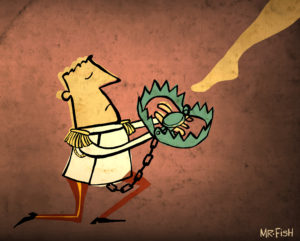Is It Lady Who’s Gaga or the Senate?
We live in two simultaneous but radically incongruous realities, where undemocratic arrangements negotiated in the 18th century contend with commercial media industries that covet the enlightened youth.
The sight of the overexposed Lady Gaga addressing a rally in Maine urging repeal of the military’s anti-gay “don’t ask, don’t tell” policy might seem merely another step on our society’s downward spiral, something akin to the surfacing of videos revealing Christine O’Donnell’s dabbling in witchcraft. But I believe that there is another message embedded in this meeting of the political and the pop: a stark illustration that we currently live in two worlds that operate according to radically disparate principles.
On the one hand we all live in the United States of America, as defined by the political terms of the U.S. Constitution, but which has greatly expanded and altered since the era of 13 founding colonies. At that time, the political negotiations that resulted in our constitutional system focused on the competing interests of rural and urban power blocs — note the placement of state capitols such as Albany and Harrisburg far from the metropolitan population centers — and the tensions between slave-holding and anti-slavery states. The resulting legislative system of two equal but very different bodies, giving proportional representation in the “lower” house and equal representation to each state in the “upper” house has led, over the intervening 11 score years, to a radically undemocratic political system. To put it simply, our current setup gives states with relatively tiny populations the same political power in the Senate, arguably the more powerful of the two congressional bodies, as states with enormous populations. To put it in concrete terms, there are seven states with populations so small that they rate only one member of the House of Representatives (Montana, Delaware, South Dakota, North Dakota, Alaska, Vermont and Wyoming), and their combined populations add up to approximately 5,200,000, which is considerably less than the population of New York City (approximately 8.3 million) or upstate New York [11.2 million]. Four adjacent western states — Montana, Wyoming and the Dakotas, have a total of less than 3 million residents, whereas Los Angeles has close to 4 million.
And it’s not merely a matter of numbers. Most of the states with the smallest populations are disproportionately older, more rural, whiter, less educated and more religious than the country as a whole, and certainly when compared with the largest states: California, Texas, New York, Florida, Illinois, Pennsylvania and so on.
What this translates to in the political realm, as we are all too aware, is enormous deference to the interests of these “atypical” population groups, which are more conservative, more religious, more hostile to minorities and change. The differences between the House and the Senate, in composition and in political leanings, bear out this disproportionate weight distribution.
On the other hand, we also live in a country increasingly dominated by a common culture that is driven by the commercial interests of the entertainment-oriented mass media industries. These industries are focused not on the relative power of groups favored by the arrangements negotiated by the Founders in 1789, but on the interests of those who pay them for the opportunity to reach their viewers, the advertisers. And, as is well known, if not scientifically supportable, these advertisers are disproportionately interested in the young, the urban and the trendy. Thus, it is hardly surprising that the content of most of our commercial media is offensive to large swathes of our population, in particular, the older, more religious, more rural, less educated — in other words, to those whose representatives in the Senate carry disproportionate political power.
This disparity in the political system — composed of elements notably deferential to the interests of one segment of the population and the dominant commercial media industries, avidly seeking the eyes, hearts and disposable income of a vastly different segment of the population — inevitably leads to contradictions that often seem hard to explain, but in reality aren’t very complicated. Over the past few decades we have been treated to repeated episodes in which members of Congress, usually senators, conduct “show trial” hearings to condemn the representatives of one or another branch of the entertainment media, from comic books to network TV to rock music to movies to video games, demanding censorship to protect innocent youth from the baleful influence of content sure to be offensive to their real audience, the voters back home. And, each time, the industry leaders promise to police themselves, label their products (making the good stuff all the easier for youngsters to find), build in parental controls and, at the same time, avoid the threat of legislative limitations (which, they know well, rarely survive constitutional challenge). So, each side is able to serve its own interests without fundamentally challenging the inexorable tide of cultural change — for many the appropriate term is corruption — that is mandated by the media’s need to reach the audience desperately sought by advertisers.
In the realm of what we politely refer to as “social issues,” we can see the same dynamic at play. For younger segments of the population, who grew up knowing that Ellen Degeneres was, yep, gay, and probably knowing lesbian and gay classmates, friends and even relatives, the “wedge” issue so beloved of the right — it was, after all, an issue that drew large bipartisan majorities in Congress to pass “don’t ask, don’t tell” and the Defense of Marriage Act, both supported and signed by President Bill Clinton — has lost the power to generate fear and loathing. Demography is on the side of justice in this case, and the commercial media understand that full well. As a recent poll showed, among individuals ages 18 to 29, an estimated 65 percent support marriage equality, and Gallup reports that 70 percent of Americans favor allowing gays to serve openly in the military. The handwriting is on the wall.
Unfortunately, history usually moves slower than time, and many lives will be diminished, damaged and even destroyed before our political system catches up with our culture. The undemocratic arrangements negotiated in 18th century Philadelphia will remain with us for a long time, in part because no one knows how to reopen negotiations without risking arrangements far more dangerous. And so we will continue to live in two simultaneous but radically incongruous realities, while our political leaders remain in thrall to conservative constituents and obedient to their corporate patrons.
Larry Gross is the director of the USC Annenberg School for Communication. A specialist in media and culture, art and communication, visual communication and media portrayals of minorities, Gross helped found the field of gay and lesbian studies.
Your support matters…Independent journalism is under threat and overshadowed by heavily funded mainstream media.
You can help level the playing field. Become a member.
Your tax-deductible contribution keeps us digging beneath the headlines to give you thought-provoking, investigative reporting and analysis that unearths what's really happening- without compromise.
Give today to support our courageous, independent journalists.




You need to be a supporter to comment.
There are currently no responses to this article.
Be the first to respond.